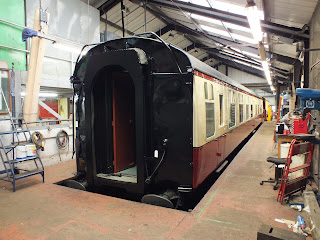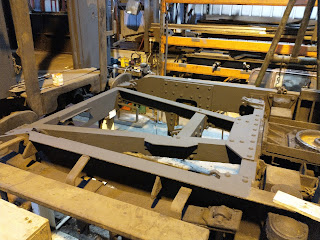As part of preparing to write this year's review, the equivalent for 2020 was read and it was immediately quite sobering to be reminded of how low morale was after the first year of Covid with the associated lockdowns, staff redundancies and loss of output for the C&W department. Whilst it is true that Covid is still very much with us, and I hesitate to give the subject too much "air time", what is quite clear is that 2021 has been much improved over 2020! More restoration time has been available and output has correspondingly risen. It's true that it will take years to return to previous levels, however given the circumstances we have done well in 2021.
January dawned with four staff taken off the furlough scheme but volunteers still at home. The latter part of the previous year had seen work reduced to outside contracts only, however the management team decided in the New Year to return to domestic based restoration work. Three projects were being progressed: the contract overhaul of the second bogie for Thompson E1866, the Gold overhaul of Mk1 BCK E21224 and winter examinations of running stock to allow for sets to be available to run throughout 2021.
In February the Thompson bogie overhaul project was completed with E1866 being handed back to the Joint Heritage Coach Fund. This coincided with a return of their volunteers who set to mainly continuing the interior restoration of the vehicle. Mk1 E21224 was moved into the staging area for exterior completion and painting.
March saw the completion of the painting of E21224, although this was not to be the end as much interior completion would be required. A new project was also started in the form of overhauling the Southern Railway Brakevan at Holt, which was set up inside a scaffold tent to allow two teams to operate, one at Holt and one at Weybourne, to allow more volunteers to return to the railway without exceeding the social distancing limits imposed at Weybourne.
April saw trains start running again which provided a boost as well as a return of the running repairs to stock which was merrily being destroyed by the traveling public once again! In the workshop E21224 was having its guards area fitted out and E1866 was being sanded down for eventual repainting. At Holt, the SR brakevan continued to display more wood rot and some sign-writing was added to the container in the freight set, a loose end which never got done during the vehicle's restoration and had been on the "to do" list for many years.
In May we stepped up a gear and introduced another two projects. Mk1 TSO E4641, which had badly faded paintwork and damage following a chemical accident whilst being cleaned, was brought in and given a quick repaint and varnish. A privately owned Box Van, the restoration of which had stalled at the 95% mark due to the owner's ill health, was brought in for volunteers to complete the last of the jobs and make it suitable for introducing back into service in the freight train. Lots of other smaller repairs were also being undertaken during this time to the Mark 1 service fleet.
June was a consolidation month, with all the existing projects such as Thompson E1866, Mark 1 E21224, the Box Van and SR Brakevan all progressing nicely. The Class 31 diesel also entered the shed in order to be repainted.
July saw the railway's first major enthusiast event held following Covid, the Mixed Traction Gala. The opportunity was taken to launch two vehicles at the event following major overhauls, the Class 31 and the box van. This would prove to be a highlight for the year with an air of optimism and warmer weather.
In August E21224 had been completed up to a point where it could carry passengers, although it was by no means finished with many interior items still missing. It was needed for certain trains during the high summer so was temporarily put into traffic. The departure of this and the Class 31 from the shed allowed half of the workshop to be emptied for a major tidy up and a floor repaint, which was overdue by about 10 years!
By September the tent had been removed from the SR brakevan at Holt but the restoration, although well advanced, had not quite been completed. After a brief spell outside, it was arranged for the vehicle to be shunted under the awning at Holt museum to be finished off. Mark 1 E21224 had also returned to Weybourne for lots of snagging and minor jobs to be attended to, whilst sister BCK vehicle E21103 was brought into the workshops and quickly dismantled externally for a Silver bodywork overhaul.
In October the infamous conveyor belt project was launched: an audacious "Covid kick-back" scheme to undertake emergency water ingress and interior repairs and apply paint and varnish externally to 13 vehicles before the summer of 2022:
- The Suburban 4 set
- Two Mark 1 TSO vehicles and a CCT from the main maroon service set
- Two Mark 1 dining coaches
- The Quad-Art set
November saw the conveyor belt continue with suburban W46139 bringing the total up to three. An added bonus was Southern Railway CCT S1439S, which was privately owned and also being worked on privately, which emerged from the Loco shed following a few months of exterior repairs and a partial repaint. Dining train FO M3116 also made a brief visit to the workshop to have some asbestos lagging removed by contractors to allow steam heat repairs to be undertaken allowing the vehicle to return to use on winter services (having been confined to summer only for the past year or two). Class 37 D6732 also followed in the Class 31's footsteps by coming into the shed for its own repaint. This time however it was to be done by contractors Heritage Painting as there was too much stress on the home resources to undertake in house given the amount of refreshes going on with other vehicles.
Finally, December saw Mark 1 E21224 dispatched to the North Yorkshire Moors Railway for the fitting of its Network Rail approved toilet to allow it to operate on the mainline after 2023. Upon its return we officially classed its major four year Gold overhaul completed, so it can finally take a break from the pages of this Blog! The conveyor belt continued with suburbans E48001 and E43357 being refreshed bringing the total up to five, which was just in time to stay on target (we aimed to have five completed by 2022) in the overall scheme.
The current occupants of the shed are: Thompson E1866 (ongoing Gold overhaul), Mark 1 BCK E21103 (Silver overhaul to be completed 2022), Suburban E43357 (complete awaiting dispatch) and Class 37 D6732 (repaint to be completed 2022). Of course the SR Brakevan is also at Holt and reportedly only has a few more days work ahead before it too is completed, with the aim of relaunching it at the Spring Steam Gala.
In 2021 we completed the major overhauls of two vehicles, with a further eight receiving repaints and many more having minor intermediate repairs. This is a good output for a still depleted department. Looking ahead into 2022, the first half of the year will see a continuation of the quick refreshes that have dominated the latter half of 2021, before hopefully we can return to some more thorough overhaul work again later in the year. 2021 has been a much better result than 2020, so we hope to build further on this and do even better next year!
























































